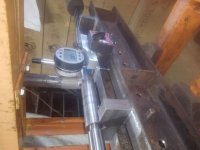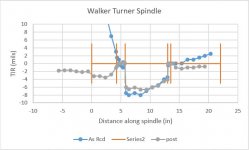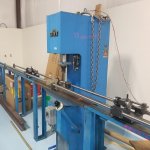I am restoring a 1940s vintage 20" Walker Turner drill press. The spindle extends about 5 inches from the bottom of the quill. The Chuck and spindle had a visible runout when turned on. The rest of it seemed heavy duty and in decent shape so it followed me home for $200. It was clear part of the problem was the drill arbor so it was removed from the chuck by welding a washer to it and using wedges. The MT2 female spindle taper was nasty and cleaned up on the bench with a finish reamer and tap wrench. A test bar now fits nicely.
The spindle was set on V blocks at the bearing locations and runout was measured along the test bar and spindle, The data is shown in blue. The test bar about 6" from the spindle the indicator was reading +/- 35 mils, (TIR 70 mils) this is about where the tip of a drill bit would be. The TIR decreases to the lower bearing location where the V block is. The area between the 2 bearings is roughly turned and not concentric with the ground bearing locations (no concern here). The spline area above the top of the top bearing is not too bad.
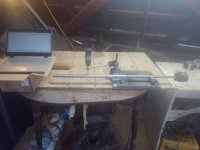

Next I built another V block fixture that would support the spindle at the bottom end and top bearing in the 12T hydraulic press. The press applies a load adjacent to the lower bearing location. A 1/10 mil x 1" indicator was used to measure the deflection at the bearing location. The procedure was to slowly apply and remove a "safe" load, record the maximum deflection seen then rotate the unloaded shaft and record the resulting maximum and minimum readings. This is repeated with increasing loads until TIR approaches zero. After each load cycle, the spindle is removed from the press and the TIR at a single point on the test bar is recorded with the shaft on V blocks at the bearing locations. I was thinking it is more important for the test bar to run true than the bottom of the spindle. Sorry about the rotated photo.

The next chart shows the measured TIR at the 2 points (2 different fixtures) as the straightening proceeded. As I got closer I was watching the chart with each load to try to predict what the next safe one should be. It looks like I went just a little too far.
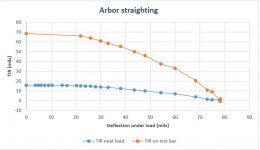
Lessons learned. 1st, I bought this double ended test bar because I knew I would need MT3 for a future project, however it is so long that I had to add a weight to the top of the spindle to get it to balance on the V block, should probably of just bought a set of 2 shorter test bars. 2nd, for the first several load cycles the spindle was rotated in the press to find the high spot and then loaded, as I got closer to zero it became less obvious where the high side was and I accidently applied a small load with the spindle at the wrong rotation. I should have clearly labeled the shaft, this side up for load. I have removed this embarrassing and confusing data from the chart.
I also re-plotted the same data as the change in TIR from the initial condition, I think this suggests how much I would need to deflect the spindle to get it better. It also seems to show the bottom part of the spindle may be bent slightly.

That is my attachment limit for this post,
The spindle was set on V blocks at the bearing locations and runout was measured along the test bar and spindle, The data is shown in blue. The test bar about 6" from the spindle the indicator was reading +/- 35 mils, (TIR 70 mils) this is about where the tip of a drill bit would be. The TIR decreases to the lower bearing location where the V block is. The area between the 2 bearings is roughly turned and not concentric with the ground bearing locations (no concern here). The spline area above the top of the top bearing is not too bad.


Next I built another V block fixture that would support the spindle at the bottom end and top bearing in the 12T hydraulic press. The press applies a load adjacent to the lower bearing location. A 1/10 mil x 1" indicator was used to measure the deflection at the bearing location. The procedure was to slowly apply and remove a "safe" load, record the maximum deflection seen then rotate the unloaded shaft and record the resulting maximum and minimum readings. This is repeated with increasing loads until TIR approaches zero. After each load cycle, the spindle is removed from the press and the TIR at a single point on the test bar is recorded with the shaft on V blocks at the bearing locations. I was thinking it is more important for the test bar to run true than the bottom of the spindle. Sorry about the rotated photo.

The next chart shows the measured TIR at the 2 points (2 different fixtures) as the straightening proceeded. As I got closer I was watching the chart with each load to try to predict what the next safe one should be. It looks like I went just a little too far.

Lessons learned. 1st, I bought this double ended test bar because I knew I would need MT3 for a future project, however it is so long that I had to add a weight to the top of the spindle to get it to balance on the V block, should probably of just bought a set of 2 shorter test bars. 2nd, for the first several load cycles the spindle was rotated in the press to find the high spot and then loaded, as I got closer to zero it became less obvious where the high side was and I accidently applied a small load with the spindle at the wrong rotation. I should have clearly labeled the shaft, this side up for load. I have removed this embarrassing and confusing data from the chart.
I also re-plotted the same data as the change in TIR from the initial condition, I think this suggests how much I would need to deflect the spindle to get it better. It also seems to show the bottom part of the spindle may be bent slightly.

That is my attachment limit for this post,


